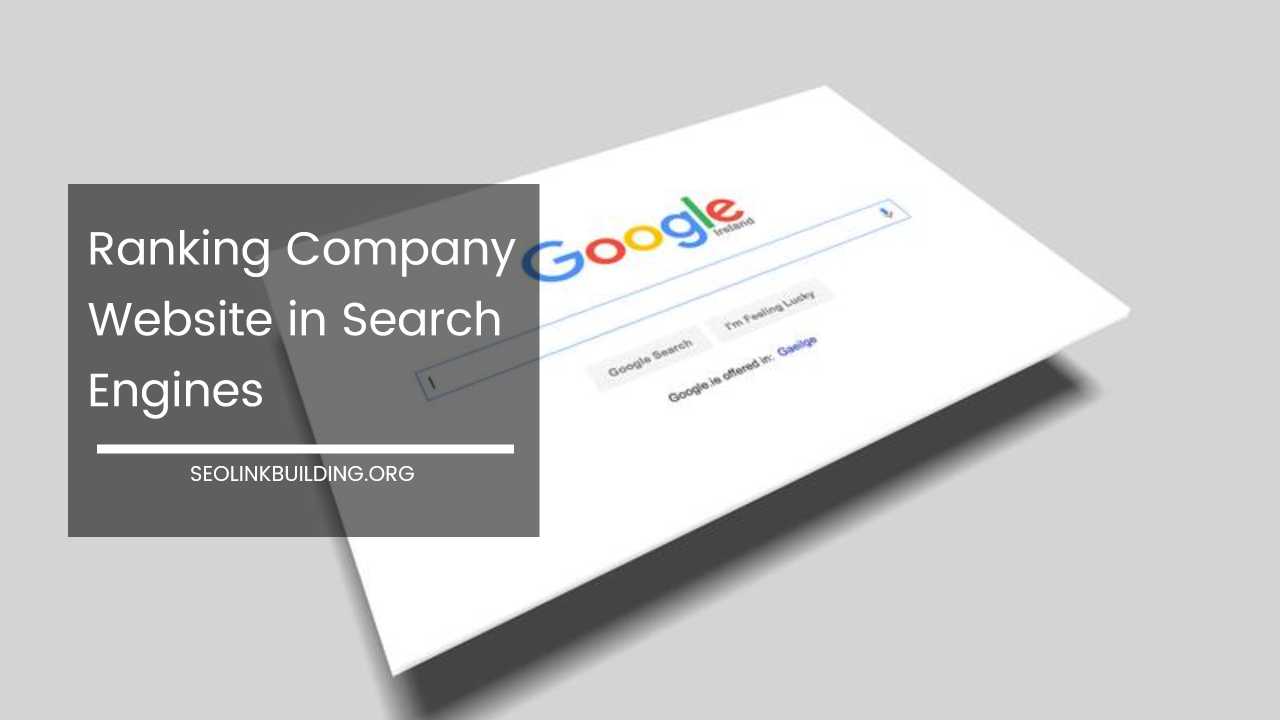How to Rank Your Company Website Higher in Search

Dominate the Digital Landscape: Ranking Your Company Website in Search Engines
In today’s digital age, a strong online presence isn’t optional – it’s the lifeblood of your business. When potential customers seek out products or services, search engines are their primary gateway.
This makes achieving a prominent position on search engine results pages (SERPs) crucial for driving qualified traffic, generating leads, and ultimately, boosting your bottom line.
This comprehensive SEO (Search Engine Optimization) guide will equip you with the knowledge and strategies to propel your company website to the top of search engine rankings.
Understanding the Search Engine Landscape – A Deeper Dive
While Google undoubtedly reigns supreme with over 80% of the global search market share, don’t discount the reach of other players like Bing, Yahoo!, and DuckDuckGo. Each search engine has its own ranking algorithm, but they all prioritize similar factors:
- Relevance: Does your website content comprehensively address the user’s search intent?
- Authority: Is your website established and trusted within your industry? Factors influencing authority include backlinks, brand mentions, and positive user reviews.
- User Experience (UX): Does your website offer a seamless experience for users across all devices? This encompasses mobile-friendliness, easy navigation, and fast loading times.
Climbing the SEO Ladder: Key Strategies for Ranking Success
1. Keyword Research: The Bedrock of SEO
Keywords are the building blocks of your SEO strategy. They are the terms users type into search engines to find information.
By identifying relevant keywords with high search volume and low competition, you tailor your website content to attract your target audience.
- Utilize advanced keyword research tools: While free tools like Google Keyword Planner offer valuable insights, consider exploring paid options like SEMrush, Ahrefs, or Moz. These tools provide deeper keyword research capabilities, including competitor analysis and keyword difficulty.
- Target a strategic mix of keywords: Focus on a combination of high-volume head keywords (broad search terms) and long-tail keywords (more specific phrases). Head keywords attract broader traffic, while long-tail keywords generate leads with higher conversion intent.
- Incorporate keywords naturally: Don’t resort to keyword stuffing, a black-hat SEO tactic that negatively impacts user experience and can penalize your ranking. Instead, integrate keywords organically within your content to ensure readability and relevance.
2. Content is King: The Power of Compelling and Diverse Content
Search engines favor websites that offer high-quality, informative content that solves user problems or fulfills their needs.
- Create a content calendar: Plan your content strategy well in advance. A content calendar helps you maintain consistency, target a wider range of keywords, and address various user needs through different content formats.
- Diversify your content formats: Balance informative blog posts with engaging infographics, videos, user guides, case studies, and even interactive content to cater to different learning styles and preferences.
- Maintain content freshness: Regularly update your website with fresh content to keep users engaged and signal activity to search engines. Aim for a consistent publishing schedule, but prioritize quality over quantity.
- Optimize for local SEO (if applicable): If your business has a physical location, target local keywords and utilize Google My Business to improve local search ranking. Include your business address, operating hours, and positive customer reviews to enhance your local SEO profile.
3. Technical SEO: Ensuring Your Website’s Crawlability and Usability
Technical SEO encompasses the behind-the-scenes factors that make your website search engine friendly and user-friendly. Here’s a deeper look at key technical SEO aspects:
- Mobile-first optimization: With the majority of searches now conducted on mobile devices, ensure your website offers a seamless mobile experience that goes beyond simply being responsive. Optimize for fast loading times, prioritize user-friendly buttons and forms, and consider implementing Accelerated Mobile Pages (AMP) for faster mobile content delivery.
- Optimize website speed: Slow loading times can significantly hurt both your rankings and user engagement. Utilize website speed testing tools like Google PageSpeed Insights to identify and rectify performance bottlenecks. Consider website caching plugins, image optimization techniques, and a reliable content delivery network (CDN) to improve speed.
- Ensure clear website structure and navigation: Search engines and users alike value a well-structured website with clear and intuitive navigation menus and internal linking. Internal linking helps search engines understand the hierarchy and relationships between your web pages, while users can easily find relevant information within your website.
4. Backlink Building: Earning the Currency of Trust
Backlinks are essentially votes of confidence from other websites to yours. The more high-quality backlinks you have pointing to your website, the more authoritative your website appears in the eyes of search engines.
However, quality matters more than quantity. Building backlinks from irrelevant or low-authority websites can have negative consequences. Here are some effective strategies to earn high-quality backlinks:
- Guest blogging: Contribute valuable content to relevant industry blogs or publications with established audiences. Include a natural and relevant backlink to your website within your author bio. Ensure the publications have a good domain authority and adhere to white-hat SEO practices.
- Broken link building: Identify broken links on websites within your niche and offer your content as a replacement. This involves reaching out to the website owner and politely suggesting your content as a more valuable and up-to-date resource.
- Online directories and listings: Submit your website to relevant online directories and business listings to increase visibility and acquire backlinks. Prioritize high-quality directories with strong domain authority.
- Create link-worthy content: People are naturally inclined to link to valuable, informative, and shareable content. Focus on creating content that establishes your expertise and provides genuine value to the audience.
5. User Experience (UX) Optimization: Prioritizing User Engagement
Search engines prioritize websites that offer a positive user experience (UX). Here’s how to optimize your website for user engagement:
- Prioritize website clarity and visual appeal: Use high-quality images, clear fonts, white space, and a visually appealing layout to keep users engaged and make it easy for them to find the information they need.
- Focus on website usability: Ensure your website is easy to navigate with clear menus, intuitive site architecture, and prominent calls to action (CTAs) that guide users towards taking a desired action.
- Optimize for mobile: As mentioned earlier, a seamless mobile experience is crucial. Test your website across various mobile devices to ensure smooth functionality and a positive user experience.
Beyond the Climb: Maintaining Your SEO Success
SEO is a continuous process, not a one-time fix. Here are some additional tips to ensure long-term SEO success:
- Stay updated on algorithm changes: Search engine algorithms are constantly evolving. Stay informed about the latest updates from Google, Bing, and other search engines through industry blogs and publications. Adjust your SEO strategy accordingly to stay ahead of the curve.
- Utilize analytics tools: Leverage tools like Google Search Console and Google Analytics to gain valuable insights into your website traffic, keyword performance, user behavior, and backlink profile. Use these insights to identify areas for improvement and refine your SEO strategy.
- Embrace local SEO: If your business has a local focus, consistently update your Google My Business listing, manage customer reviews effectively, and participate in local online communities to build brand awareness and establish local authority.
Final Thoughts: The SEO Journey – A Continuous Pursuit
By implementing these strategies and remaining committed to ongoing SEO efforts, you can significantly improve your website’s ranking in search engine results pages.
Remember, SEO is a journey, not a destination. It requires consistent effort, ongoing monitoring, and adaptation to stay ahead of the curve.
However, the rewards of achieving top search rankings are significant – increased website traffic, qualified leads, and ultimately, a thriving online presence for your business.













